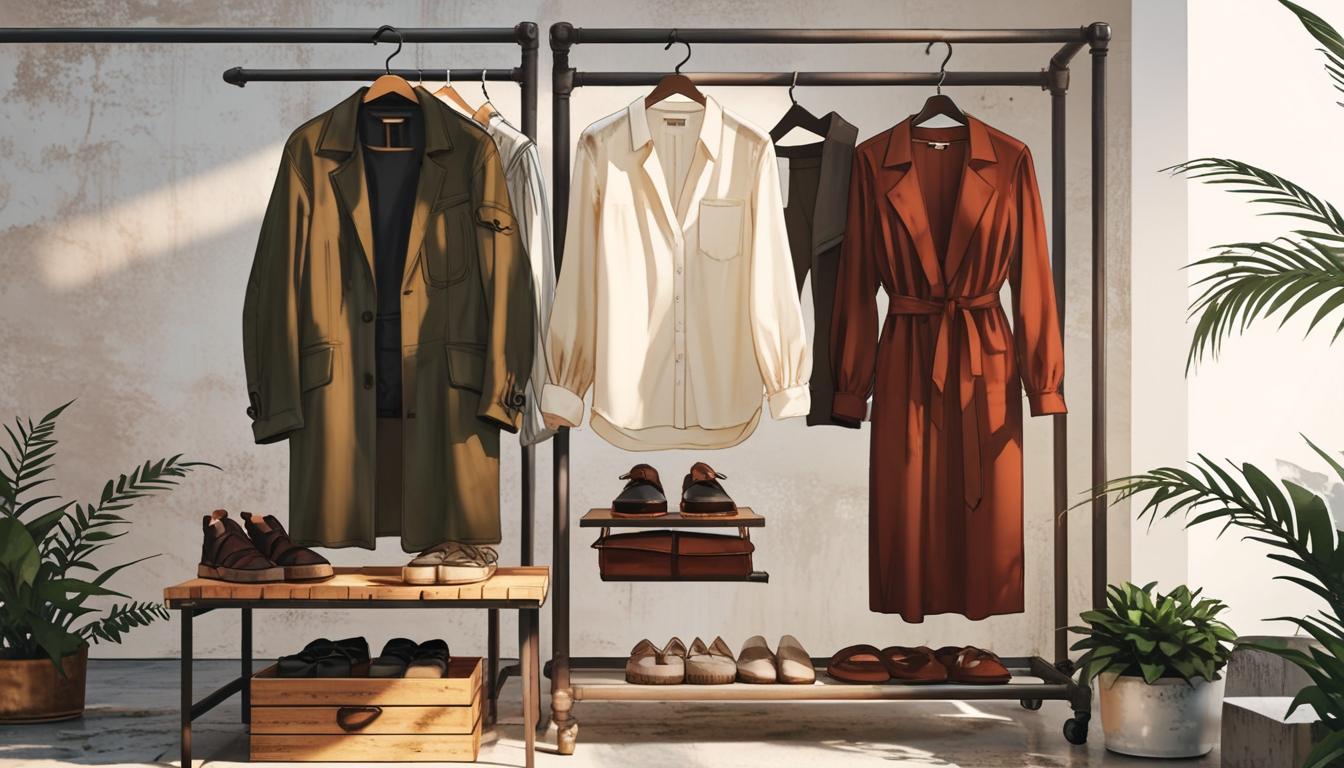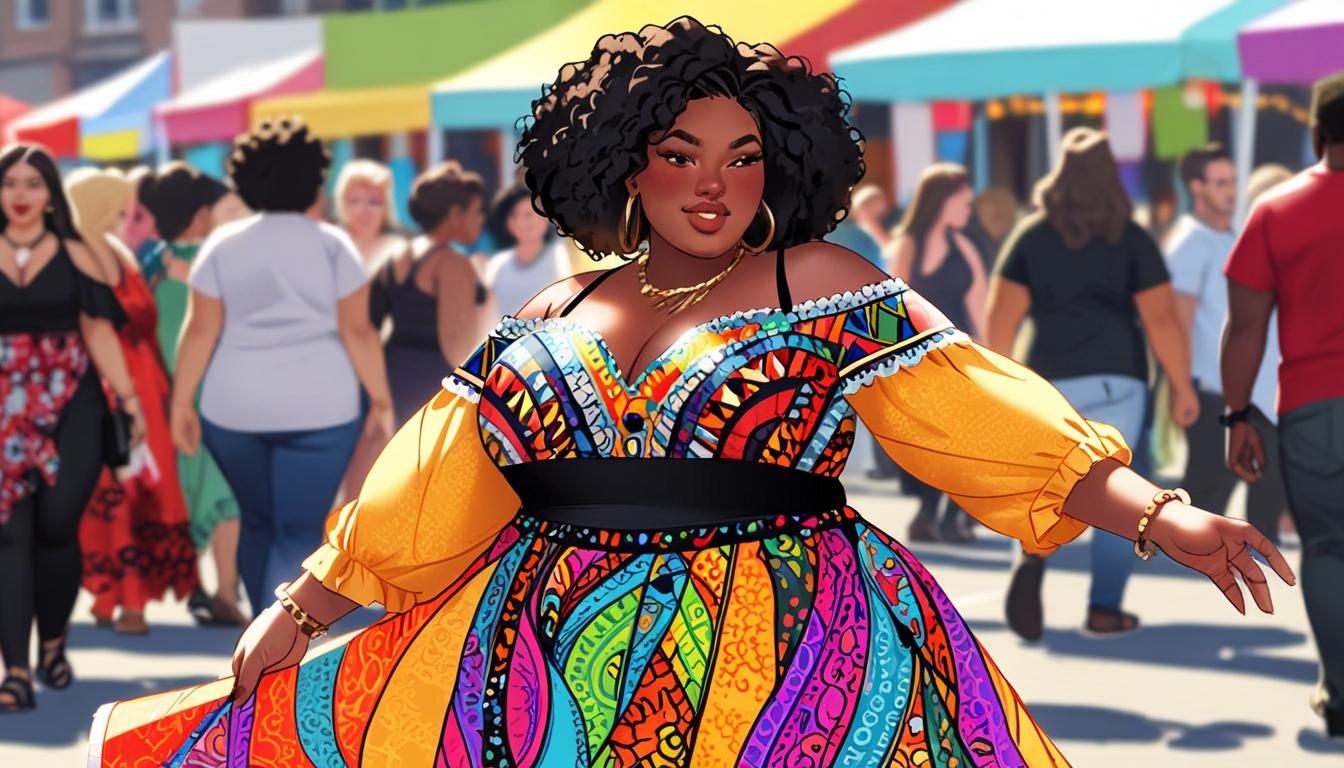You might think of Joan Baez as just a folk singer, but her fashion choices reveal a deeper narrative. Each outfit she wore tells a story of activism and artistic expression, whether it was the flowing dresses at Woodstock or the meaningful accessories she sported at Live Aid. These iconic moments not only defined her style but also made bold statements about the social issues she championed. What might surprise you is how her evolving wardrobe reflects the changing landscape of activism and fashion over the decades.
Joan Baez: A Fashion Trailblazer
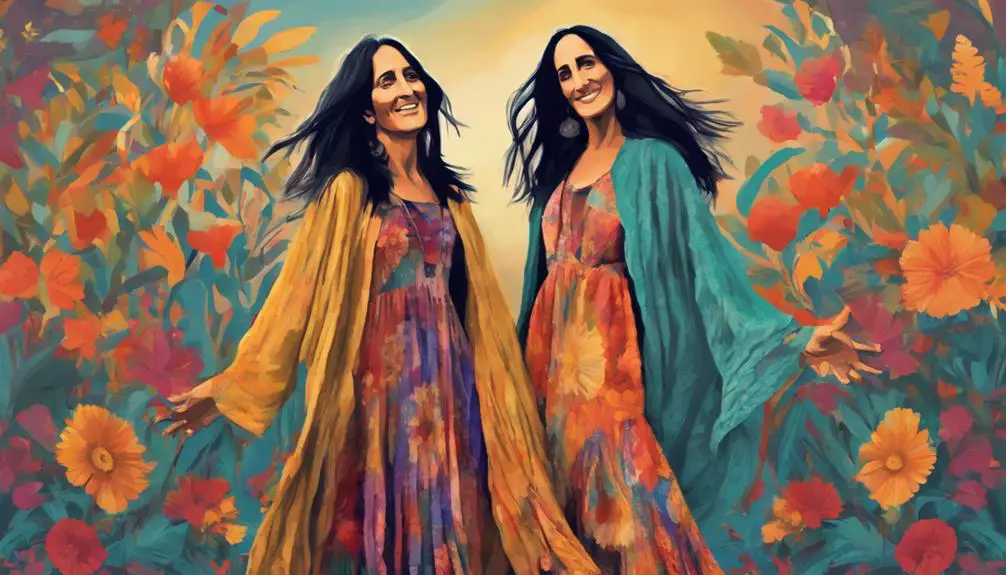
Joan Baez stands out as a true fashion trailblazer, effortlessly blending music and style in a way that defined an era. You can't help but admire how she pioneered bohemian fashion in the 1970s, showcasing flared cords, parachute skirts, and stunning handmade jewelry. Each piece she wore reflected the free-spirited essence of the time, making her a beacon for those seeking authenticity and peace.
Her iconic spoon necklace, famously worn during her performance at Live Aid, became a symbol of her unique style, highlighting her ability to merge fashion with meaningful statements. Joan Baez's choices embraced natural, handmade materials, resonating profoundly with the hippie movement's core values. You'd often find her adorned in eclectic accessories, her long hair flowing freely, perfectly encapsulating the flower child ideal of the 1960s.
But what's truly fascinating is her minimalist approach to fashion. Baez regularly purged her personal belongings, keeping only a few treasured items that aligned with her lifestyle. This approach not only showcased her distinctive look but also reflected a deeper connection to her values.
In every outfit, she told a story, inviting you to join her journey of self-expression. Joan Baez didn't just wear clothes; she made statements that resonated with a generation. Her impact on fashion transcends mere trends, inspiring countless individuals to embrace their own unique styles, rooted in authenticity and individuality.
Influences of Bohemian Style
Bohemian style, with its vibrant colors and eclectic patterns, draws heavily from a blend of artistic movements and cultural influences that champion freedom and individuality. This enchanting style emerged prominently in the 1970s, a decade marked by a surge of social change and creative expression. Joan Baez played a significant role in popularizing bohemian fashion, embracing flared cords, parachute skirts, and handmade jewelry that perfectly embodied the free-spirited ethos of the era.
When you think of Baez, her iconic spoon necklace often comes to mind, especially when she wore it during significant performances like Live Aid. This piece not only symbolized her unique style but also connected her to the counterculture movement. Her fashion choices were deeply reflective of the hippie movement, which prioritized natural materials and comfort over expensive garments, showcasing a strong desire to break free from traditional fashion norms.
Baez's wardrobe featured ethnic designs and floral patterns, hallmarks of bohemian style that emphasized individuality and self-expression. Intriguingly, her approach to fashion also mirrored minimalist and anti-materialist values prevalent in bohemian culture. By regularly purging her belongings and keeping only a few cherished items, she highlighted the importance of quality over quantity.
In embracing bohemian style, you truly connect with a legacy that champions personal expression and artistic freedom, making it a timeless choice for anyone inspired by Joan Baez's iconic moments.
Signature Looks Over the Years
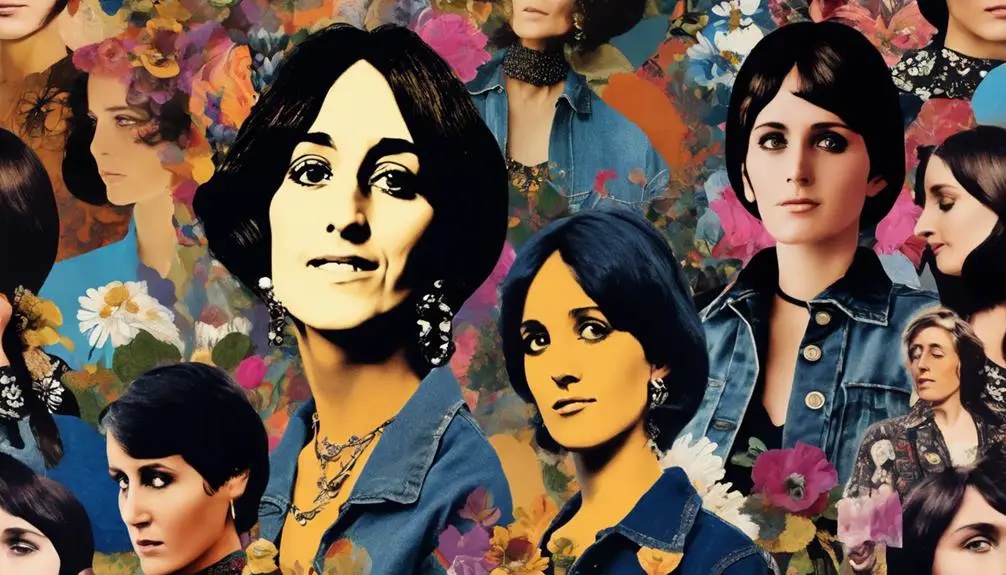
Engaging audiences with her distinctive style, Baez's signature looks evolved throughout her career, reflecting both personal growth and the cultural shifts around her. In the 1970s, you'd find her pioneering bohemian fashion, frequently donning flared cords and parachute skirts that embodied the free-spirited ethos of the era. These choices weren't just about aesthetics; they spoke to her love for comfort and natural materials over the constraints of expensive garments.
Her style often included handmade jewelry and ethnic designs, adding a personal touch to her outfits. The iconic spoon necklace she wore during her performance at Live Aid became a symbol of her connection to the music community and her unique fashion sense. Known for her long, flowing hair, Baez frequently accessorized with bandanas, further contributing to the quintessential flower child look of the 1960s.
What's truly fascinating is her minimalist approach to fashion; Baez regularly purged her personal belongings, keeping only a few treasured items that held significant meaning. This practice not only showcased her practical side but also highlighted her belief in quality over quantity.
Throughout her journey, Joan Baez's signature looks have encapsulated a spirit of rebellion and authenticity, allowing her to remain a prominent figure in both music and fashion. Her ability to adapt while staying true to herself keeps her style fresh and inspiring, reminding us that fashion is not just about clothing—it's about expressing who you are.
Iconic Accessories and Symbols
Fashion isn't just about clothing; it's also about the accessories that define a person's style and message. Joan Baez truly exemplified this notion with her iconic accessories that complemented her unique persona and activism. One of her most famous pieces was the spoon necklace, which she proudly wore during significant performances, including the legendary Live Aid concert in 1985. This necklace became a symbol of her commitment to social justice, encapsulating her artistic vision and personal beliefs.
Baez often gravitated towards handmade jewelry that reflected the bohemian aesthetic of the 1970s. These accessories, crafted from natural materials and featuring ethnic designs, emphasized comfort and a deep connection to nature, aligning perfectly with her free-spirited lifestyle and the broader counterculture movement. Each piece she wore told a story, resonating with her audience and reinforcing her message of peace and nonviolence.
Additionally, Baez frequently accessorized with items showcasing peace symbols, which underscored her advocacy for social change. This choice not only highlighted her dedication to humanitarian causes but also connected her music to the political movements of the time.
Her penchant for flared cords and parachute skirts further enhanced her distinct look, making her a fashion icon of the 1960s and 1970s within the folk music scene. By carefully selecting her accessories, Joan Baez transformed her style into a powerful statement, embodying the ideals she championed through her art and activism.
Fashion Statements at Key Events
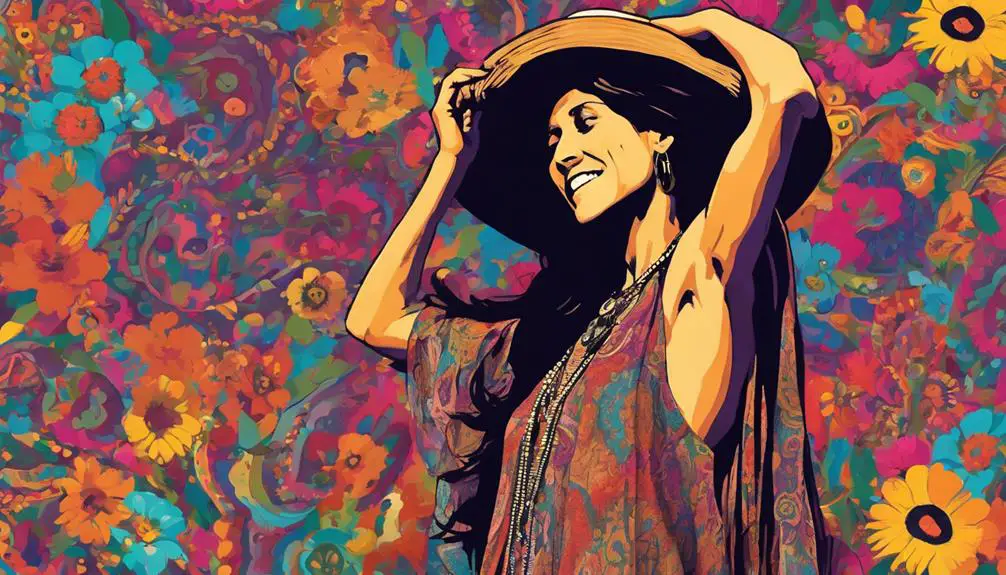
Throughout her career, Joan Baez made unforgettable fashion statements at key events that reflected her artistic vision and political beliefs. At the legendary Woodstock Festival in 1969, her flowing dresses and earthy tones perfectly embodied the spirit of peace and love that defined the counterculture movement. You could see how her style wasn't just about aesthetics; it was a declaration of her commitment to social change and harmony.
Fast forward to 1985, and you'd find her at Live Aid, where she donned a distinctive spoon necklace. This striking accessory symbolized not only her unique bohemian style but also her dedication to various social causes, making a powerful fashion statement that resonated with the audience.
In the 1970s, Baez popularized flared cords and parachute skirts, staples of bohemian fashion that aligned seamlessly with the ideals of the hippie movement. Her wardrobe often included high-waisted jeans and floral patterns, which not only showcased her individuality but also mirrored the evolving trends of the time.
Moreover, Joan's passion for handmade jewelry added yet another layer to her fashion statements. By incorporating ethnic and artisanal pieces into her outfits, she demonstrated her appreciation for authenticity and craftsmanship, making her style genuinely unique. Whether on stage or at a rally, every outfit she wore was more than just clothing; it was a powerful expression of her values and beliefs, inspiring countless fans along the way.
The Evolution of Her Wardrobe
Joan Baez's wardrobe has always been a reflection of her journey as an artist and activist, evolving alongside the cultural shifts of each decade. You can see how her fashion choices changed from conventional attire to the vibrant bohemian styles of the 1970s, embracing freedom and individuality. Flared cords, parachute skirts, and handmade jewelry became her signature looks, embodying the free-spirited essence of the era.
Her iconic spoon necklace, famously worn at Live Aid, stands out as a powerful symbol of her unique style and connection to the peace movement. This piece of jewelry not only highlighted her fashion but also her commitment to causes she deeply cared about. As the 1960s and 1970s unfolded, high-waisted jeans, fringes, and floral patterns became staples in her wardrobe, aligning perfectly with the youth culture's rebellion against traditional norms.
Baez's fashion evolution also showcased her minimalist philosophy. She regularly purged her personal belongings, keeping only a few cherished items that resonated with her authenticity. This approach to fashion allowed her to maintain a clutter-free aesthetic, emphasizing quality over quantity.
Through each phase of her life, Joan Baez's wardrobe has told a story, reflecting her values, beliefs, and the times she lived in. Her fashion choices not only celebrate her individuality but also serve as a demonstration of the power of style in expressing one's identity and mission.
Cultural Impact of Her Style
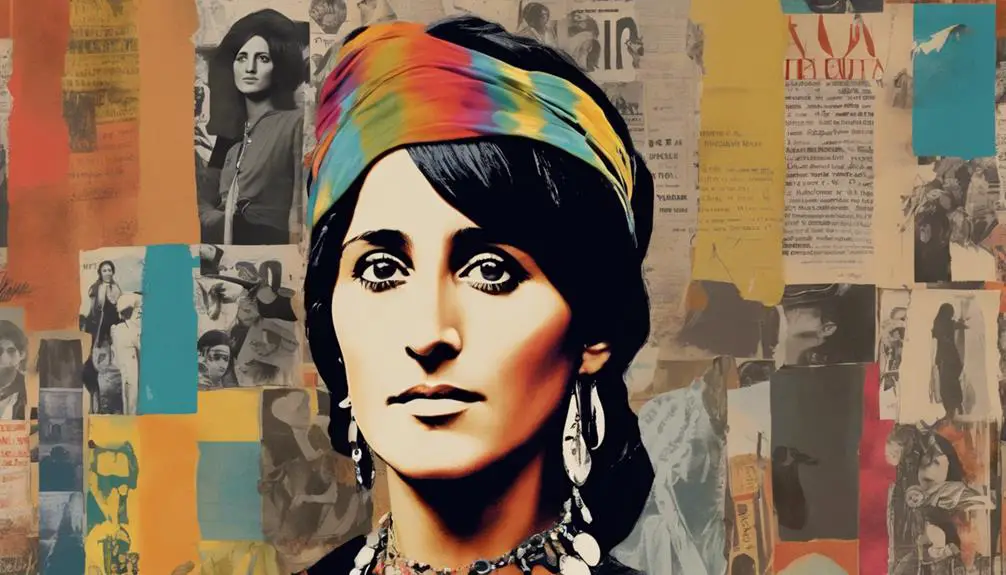
With a blend of artistry and activism, Baez's style has left a lasting cultural impact that resonates even today. You can see how her fashion choices not only defined her personal identity but also influenced the broader cultural landscape of the 1960s and 1970s. As a pioneer of bohemian fashion, she showcased a unique combination of flared cords, parachute skirts, and handmade jewelry that embodied the essence of the hippie movement. Her iconic spoon necklace, famously worn during the Live Aid concert in 1985, became a powerful symbol of her artistic identity and her unwavering commitment to social causes.
Baez's fashion choices reflected the free-spirited nature of her time, emphasizing comfort and natural materials that aligned with her anti-establishment ethos. By embracing a minimalist lifestyle, regularly purging her belongings to keep only a few treasured items, she championed authenticity and simplicity, values cherished by the counterculture movement. This approach not only made a statement about individuality and self-expression but also transformed her public image into a vehicle for activism.
In the domain of music, Baez's style reinforced her commitment to peace and social justice, inspiring countless artists and activists who followed her. Today, her fashion legacy continues to influence contemporary musicians and fashion enthusiasts alike, reminding us that style is not just about appearance but also about the messages we convey. You can feel the cultural ripple effect of her choices, urging us all to embrace our unique identities while standing up for what we believe in.
Lasting Legacy in Fashion
Baez's influence on fashion extends far beyond her own time, creating a lasting legacy that continues to inspire artists and fashion enthusiasts alike. Joan Baez pioneered bohemian fashion in the 1970s, showcasing unique styles that became essential to the counterculture movement. Her iconic style featured flared cords, parachute skirts, and handmade jewelry, all echoing the values of freedom and self-expression that defined an era. Furthermore, her wardrobe choices highlight the importance of caring for vintage items, as proper maintenance can preserve fabric integrity and color vibrancy, ensuring these treasured pieces continue to inspire future generations proper care for vintage clothing. One unforgettable piece from her wardrobe is the spoon necklace she wore during the Live Aid concert, which has become a symbol of her artistic identity, beautifully intertwining her music with the fashion aesthetics of the time. Baez's choices often reflected her free-spirited nature, emphasizing comfort and natural materials, a perfect match for the peace and love ethos promoted by the hippie movement.
As her style evolved from the 1960s to the 1980s, you can see how it mirrored broader cultural shifts in fashion. She shifted from folk-inspired clothing to more eclectic outfits, each representing individuality and a distinct sense of identity. Additionally, Baez's approach to fashion included regularly purging her wardrobe, keeping only cherished items. This practice emphasized sustainability and personal connection, setting a precedent for future generations of artists.
In essence, Joan Baez's lasting legacy in fashion isn't just about her iconic style; it's about inspiring a continued passion for self-expression, creativity, and a commitment to sustainability in the world of fashion.
Frequently Asked Questions
How to Dress Like Joan Baez?
To dress like a free spirit, embrace Bohemian Chic. Layer flowing maxi dresses with unique jewelry, opt for natural fabrics, and accessorize with peace symbols. Let your hair flow and embody individuality effortlessly. You've got this!
Who Was Joan Baez in Love With?
Joan Baez experienced several romantic relationships throughout her life, including deep connections with Bob Dylan and activist David Harris. Her love life often intertwined with her passion for social justice, reflecting her free-spirited nature.
What Is Joan Baez's Ethnicity?
Joan Baez's ethnicity reflects her rich cultural heritage, stemming from her Mexican father and Scottish-English mother. This blend of backgrounds influences her music and activism, shaping her identity and commitment to social justice throughout her life.


